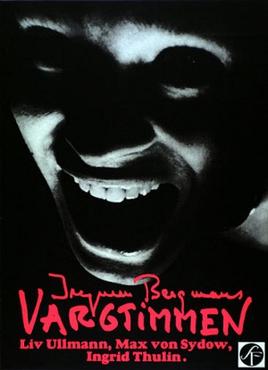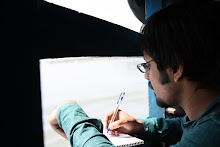
I knew of Ingmar Bergman only as a rumour till last year. I was never really that crazy about films- music does it for me- but, all that changed last August. Without a home, I was backpacking my way through people’s houses, while filling up the time with freelance work here and there, which was always quite interesting, but never financially too rewarding. It wasn’t a happy time, and I often despaired. Often I felt like chucking it all and going home, dunno why I persevered. And then, in the second house that I was passing through, I saw Hour of the Wolf. I was mildly interested by the name, but nothing prepared me for it. From the very first shot of Liv Ullman standing on a windswept northern island with that unearthly daylight grabbed me. And of course it got better.
Liv’s character Alma tells the story of her troubled artist husband Johan Borg, played by Max Von Sydow, who had gone missing a few months ago under very strange circumstances. Its one of Bergman’s few horror stories, but as with all films by him, its not just that. We get to know of some strange creatures on the same island that the couple lives in. There is the fetishistic Baron who lives “on the other side of the island”, and his strange family of assorted debauched creeps. They are obnoxious exploitative people, but Van Sydow feels they are worse…that they are monsters. One, The Birdman, apparently turns into a raven, another, The Hat Lady, threatens to take her hat, and with it, her face off. But how do we know? Through the Johan’s diaries, where he writes about his daily encounters with them on his painting trips. He even draws their monstrous images.
But is it true? Is it just that he is going through a delusional breakdown brought on by their loneliness? And what of that unsettling story of a vampire boy that Johan kills one afternoon? As the movie slowly carries with its stark still images of horrible beauty, and the occasional startlingly hideous juxtapositions of the real and the imagined, Alma starts sharing her husband’s delusions. She wonders at the end if it is possible to love someone so much that you start inhabiting their madness? One surreal day, the couples’ fragile world comes crashing down in a real/imagined sequence of utter horror and beauty when the creatures- we see their true selves at last- bait and claim the artist. But is it true? Or did he just commit suicide, or was perhaps killed by his wife? We’re never told. But the centerpiece of the film is this beautifully taut scene of the night before the fateful day. Johan is afraid of going to sleep and stays awake till dawn, with the only light coming from a candle. His drawn out, exhausted face seems etched in stone. Alma stays up with him, looking at his face with a fragile, helpless, despairing gaze. Then, after what seems like an eternity, at the still hour before dawn he diagnoses his own madness and the nature of despair…or maybe he voices his fear of the night and the shadows that inhabit it. He says that this is the crucial hour, the hour of the wolf, when most people die, when children are born, when monsters creep out of our nightmares and become real. It is as poignant as it is chilling in its portrayal of the couples’ helplessness in the face of this vast unknown. I was hooked. I think I saw it another three times in a row. Sometimes I wished that the couple had some faith. That they could steel their resolve. In fact the artist does, promising to protect his wife and their unborn child, but it is in vain. It just tips him over the edge. But I knew then, as I know now, how difficult it is for faith to be born in the face of despair. But the failure of the artist and his wife to battle their demons- real, or imagined- gave me the strength to face mine.
Now I know that it is one of Bergman’s lesser known films. Since then I’ve seen and grown to love his classics like Wild Strawberries, Persona, and The Seventh Seal. But none have touched me as profoundly as has Hour of the Wolf. And to think the Bergman passed away in that very same hour, makes me feel strange. I remember him, the fondness for movies that his films gifted me, and the way he moved me. Rest in peace.
Liv’s character Alma tells the story of her troubled artist husband Johan Borg, played by Max Von Sydow, who had gone missing a few months ago under very strange circumstances. Its one of Bergman’s few horror stories, but as with all films by him, its not just that. We get to know of some strange creatures on the same island that the couple lives in. There is the fetishistic Baron who lives “on the other side of the island”, and his strange family of assorted debauched creeps. They are obnoxious exploitative people, but Van Sydow feels they are worse…that they are monsters. One, The Birdman, apparently turns into a raven, another, The Hat Lady, threatens to take her hat, and with it, her face off. But how do we know? Through the Johan’s diaries, where he writes about his daily encounters with them on his painting trips. He even draws their monstrous images.
But is it true? Is it just that he is going through a delusional breakdown brought on by their loneliness? And what of that unsettling story of a vampire boy that Johan kills one afternoon? As the movie slowly carries with its stark still images of horrible beauty, and the occasional startlingly hideous juxtapositions of the real and the imagined, Alma starts sharing her husband’s delusions. She wonders at the end if it is possible to love someone so much that you start inhabiting their madness? One surreal day, the couples’ fragile world comes crashing down in a real/imagined sequence of utter horror and beauty when the creatures- we see their true selves at last- bait and claim the artist. But is it true? Or did he just commit suicide, or was perhaps killed by his wife? We’re never told. But the centerpiece of the film is this beautifully taut scene of the night before the fateful day. Johan is afraid of going to sleep and stays awake till dawn, with the only light coming from a candle. His drawn out, exhausted face seems etched in stone. Alma stays up with him, looking at his face with a fragile, helpless, despairing gaze. Then, after what seems like an eternity, at the still hour before dawn he diagnoses his own madness and the nature of despair…or maybe he voices his fear of the night and the shadows that inhabit it. He says that this is the crucial hour, the hour of the wolf, when most people die, when children are born, when monsters creep out of our nightmares and become real. It is as poignant as it is chilling in its portrayal of the couples’ helplessness in the face of this vast unknown. I was hooked. I think I saw it another three times in a row. Sometimes I wished that the couple had some faith. That they could steel their resolve. In fact the artist does, promising to protect his wife and their unborn child, but it is in vain. It just tips him over the edge. But I knew then, as I know now, how difficult it is for faith to be born in the face of despair. But the failure of the artist and his wife to battle their demons- real, or imagined- gave me the strength to face mine.
Now I know that it is one of Bergman’s lesser known films. Since then I’ve seen and grown to love his classics like Wild Strawberries, Persona, and The Seventh Seal. But none have touched me as profoundly as has Hour of the Wolf. And to think the Bergman passed away in that very same hour, makes me feel strange. I remember him, the fondness for movies that his films gifted me, and the way he moved me. Rest in peace.

1 comment:
want to see this movie, inter alia, soooo. trip to palika to acquire????
Post a Comment